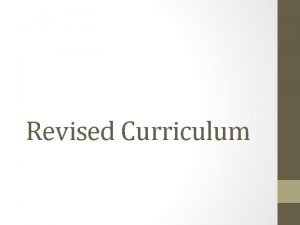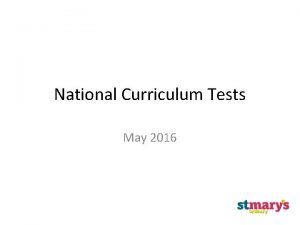The National Curriculum Why was the National Curriculum





- Slides: 5

The National Curriculum Why was the National Curriculum implemented? What are the aims and structure of the National Curriculum? What changes did the 2008 curriculum bring?

National Curriculum PE (1988 -2008) By the end of the 1980 s the government wanted � More control of education � More teacher accountability � National standards for physical education � Wider range of activities to be taught � Education Reform Act (1988) lead to the introduction of the NCPE � Return to the centralised approach to education � All state schools now follow set guidelines and are inspected by Ofsted � PE’s status was reinforced by making it compulsory for all 5 -16 year olds � Through PE children should be able to Achieve physical confidence Learn how to plan, perform and evaluate Improve self confidence Improve cognitive skills and decision making Improve social skills and leadership Improve health and fitness qualities Be able to observe and analyse activities Perform in a range of activities

National Curriculum PE (1988 -2008)(cont. ) Key Functions Therapeutic functions Raise awareness of the need for a healthy lifestyle (combat more sedentary lifestyle of modern society) Creativity Greater emphasis on creativity through formal assessment Recreational breadth Range of activities has risen (formal requirement) Schools have better facilities and greater use of community facilities More activities which you try the more likely you are to find one which you enjoy (lifelong participation) Critical performer Provide other roles in sport (official, coach and leader) Gives appreciation of other ways to be involved in physical activity Games Area of activity Dance Swimming Athletic activities Gymnastics OAA

National Curriculum PE (1988 -2008)(cont. ) Structure 4 key stages split over primary and secondary school. & 4 = secondary) (1 & 2 = primary, 3 Key stage 1 (5 -7 year olds) Limited range of activities with no choice Pupils are required to study gymnastics, games and dance Key stage 2 (7 -11 year olds) All six areas should be studied Primary school teachers aren’t usually specialists in PE Recently NGBs have begun to use lottery finding money to provide sports coaches Key stage 3 (11 -14 year olds) Wider range of activities on offer at secondary school Key stage 4 (14 -16 year olds) Gives a choice of activity

National Curriculum PE (cont. ) 2008 NCPE No longer have prescribed areas of activity to cover Instead have a range and content which they must target: Outwitting opponents, as is games activities Accurate replications of actions, phrases and sequences, as in gymnastics Exploring and communicating ideas, concepts and emotions, as in dance activities Performing at maximum levels, as in athletic activities Identifying and solving problems to over come challenges of an adventurous nature, as in OAA and swimming Exercising safely and effectively to improve health and well being, as in fitness and health activities Greater freedom for schools to deliver the curriculum which they wish Double edged sword? Can use specific local facilities surfing in Cornwall rock climbing in Forest of Dean









